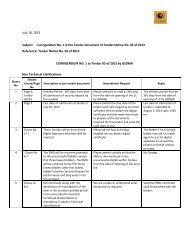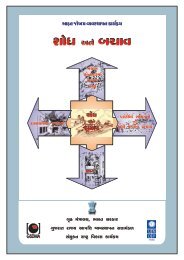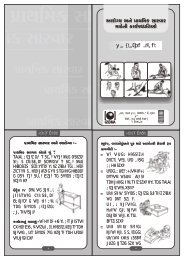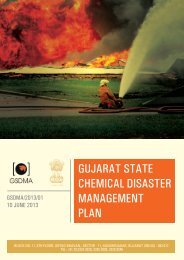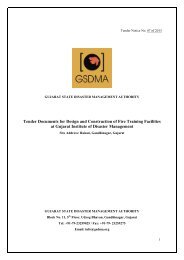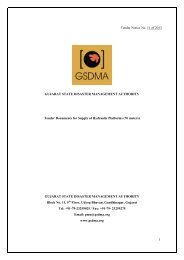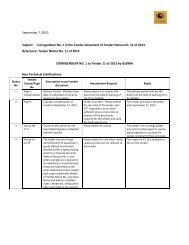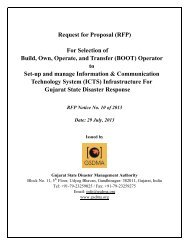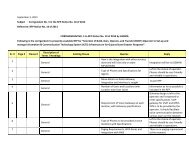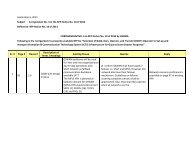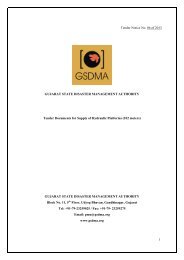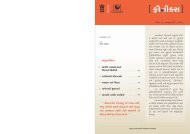Emergency Response Guidebook - Gujarat State Disaster ...
Emergency Response Guidebook - Gujarat State Disaster ...
Emergency Response Guidebook - Gujarat State Disaster ...
Create successful ePaper yourself
Turn your PDF publications into a flip-book with our unique Google optimized e-Paper software.
Protective Suits (NFPA 1992 & 1993), also known as Level B* or C* protection (OSHA 29 CFR1910.120, Appendix A & B) or suits for chemical/biological terrorism incidents (NFPA 1994), class1, 2 or 3 Ensembles and Standard CAN/CGSB/CSA-Z1610-11 – Protection of first responders fromchemical, biological, radiological, and nuclear (CBRN) events (2011). No single protective clothingmaterial will protect you from all dangerous goods. Do not assume any protective clothing isresistant to cold and/or heat or flame exposure unless it is so certified by the manufacturer (NFPA1991 5-3 Flammability Resistance Test and 5-6 Cold Temperature Performance Test).* Consult glossary for additional protection levels under the heading “Protective Clothing”.FIRE CONTROLFIRE AND SPILL CONTROLWater is the most common and generally most available fire extinguishing agent. Exercise cautionin selecting a fire extinguishing method since there are many factors to be considered in anincident. Water may be ineffective in fighting fires involving some materials; its effectivenessdepends greatly on the method of application. Fires involving a spill of flammable liquids aregenerally controlled by applying a fire fighting foam to the surface of the burning material.Fighting flammable liquid fires requires foam concentrate which is chemically compatible withthe burning material, correct mixing of the foam concentrate with water and air, and carefulapplication and maintenance of the foam blanket. There are two general types of fire fightingfoam: regular and alcohol-resistant. Examples of regular foam are protein-base, fluoroprotein,and aqueous film forming foam (AFFF). Some flammable liquids, including many petroleumproducts, can be controlled by applying regular foam. Other flammable liquids, including polarsolvents (flammable liquids which are water soluble) such as alcohols and ketones, have differentchemical properties. A fire involving these materials cannot be easily controlled with regularfoam and requires application of alcohol-resistant foam. Polar-solvent fires may be difficult tocontrol and require a higher foam application rate than other flammable liquid fires (seeNFPA/ANSI Standards 11 and 11A for further information). Refer to the appropriate guide todetermine which type of foam is recommended. Although it is impossible to make specificrecommendations for flammable liquids which have subsidiary corrosive or toxic hazards,alcohol-resistant foam may be effective for many of these materials. The emergency responsetelephone number on the shipping document, or the appropriate emergency response agency,should be contacted as soon as possible for guidance on the proper fire extinguishing agent touse. The final selection of the agent and method depends on many factors such as incidentlocation, exposure hazards, size of the fire, environmental concerns, as well as the availability ofextinguishing agents and equipment at the scene.WATER REACTIVE MATERIALSWater is sometimes used to flush spills and to reduce or direct Vapours in spill situations. Some ofthe materials covered by the guidebook can react violently or even explosively with water. Inthese cases, consider letting the fire burn or leaving the spill alone (except to prevent itsspreading by diking) until additional technical advice can be obtained. The applicable guidesclearly warn you of these potentially dangerous reactions. These materials require technicaladvice since(1) water getting inside a ruptured or leaking container may cause an explosion;(2) water may be needed to cool adjoining containers to prevent their rupturing(exploding) or further spread of the fires;Page 364Page 365



